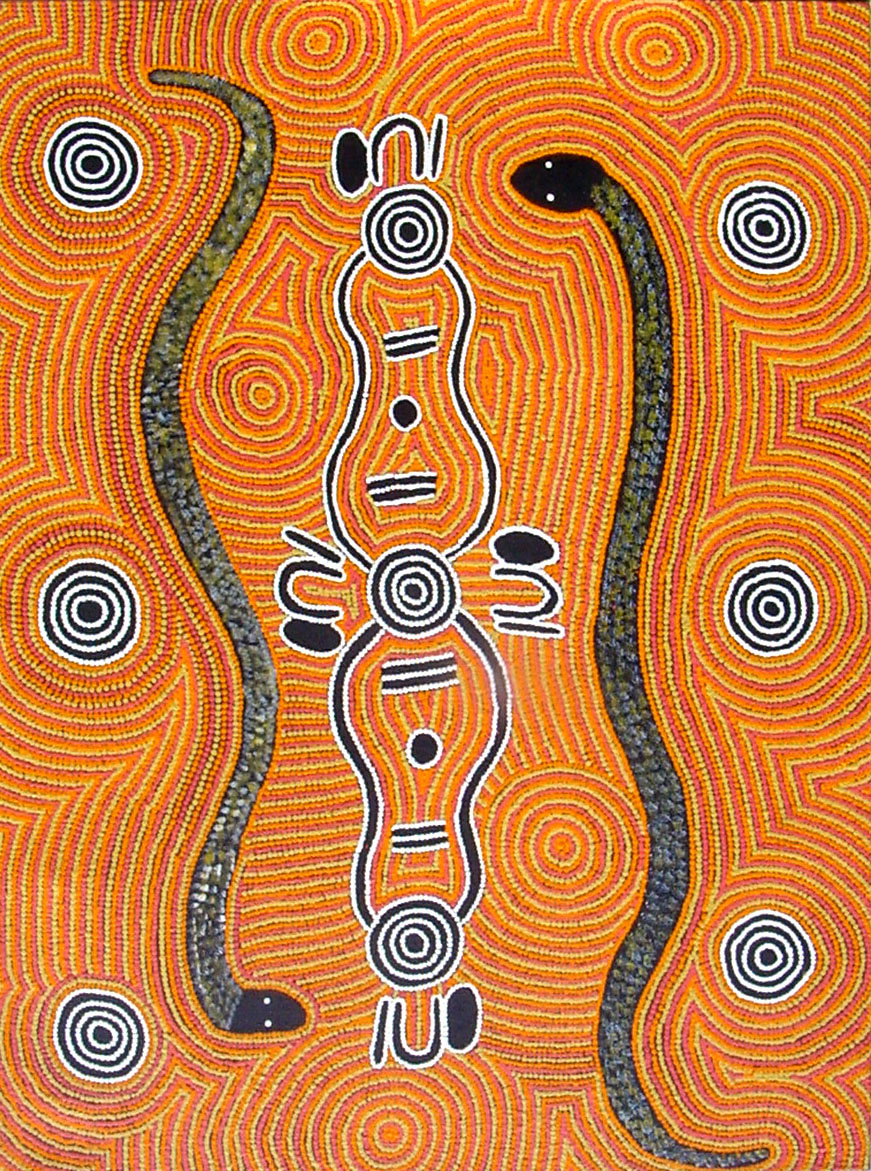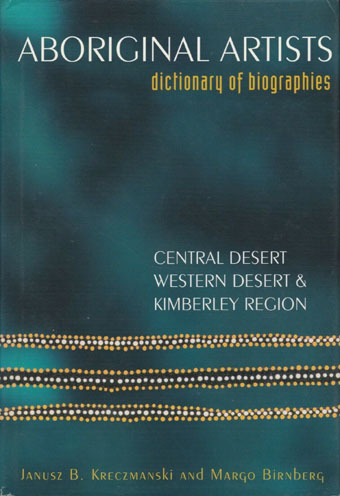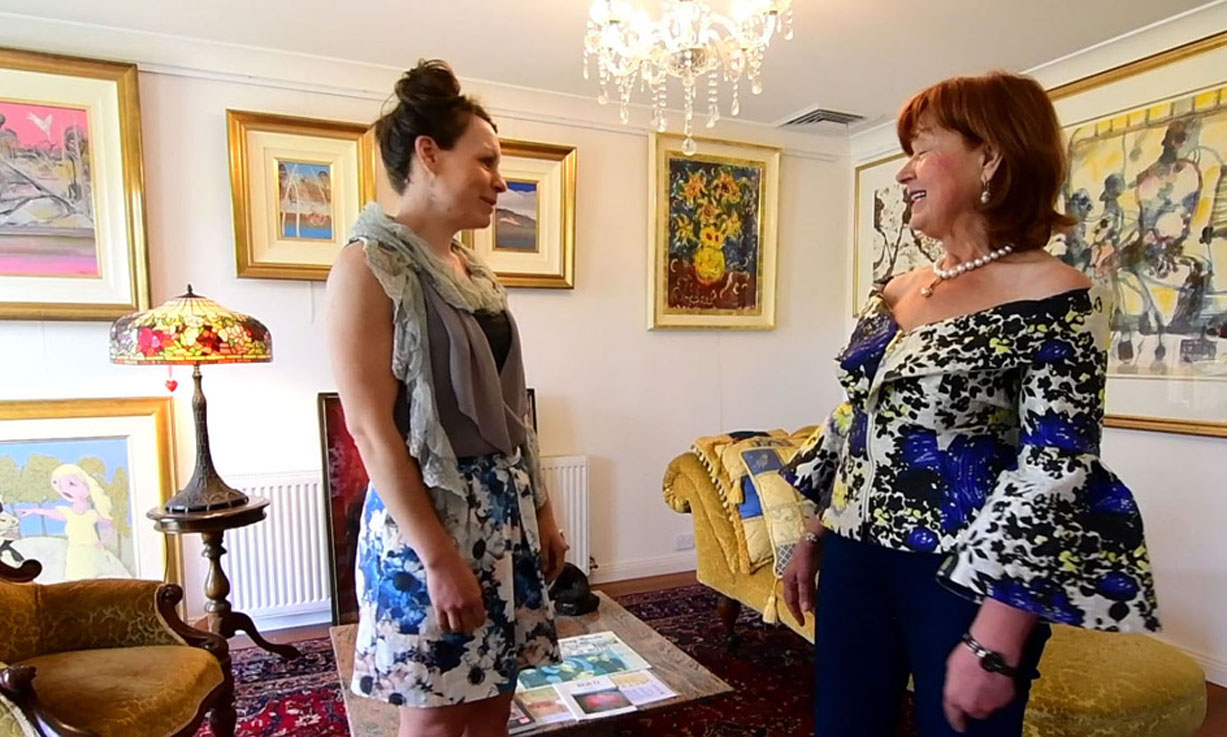|
Peggy White Nakamarra
B.1949 |
If you LOVE Art
of
impeccable
provenance,
the
art
you
want is at
Galeria Aniela
|
|
Born circa 1949, Peggy Nakamarra
White
has been painting since the 80's, working
for
Warumpi Community Arts Centre.
Peggy
Nakamarra
comes from a
long line of artists, an
ancient culture
that gave the World its most exciting Contemporary Art.
Peggy
Nakamarra
depicts the Ancestral
Rainbow Snake travel from Winbarrku to Lilliba.
Peggy depicts the Aboriginal ancestral Dreaming of
The Rainbow Serpent with great attention to details .
Peggy White
Nakamarra
work is
represented in
Central Australian Aboriginal Media
Association Collection in Alice Springs in the Northern
Territory and
Art Gallery of NSW. |
|
|

Peggy
White
Nakamarra
Rainbow
Snake (2002)
Synthetic polymer paint on
Belgian linen
Image
size: 123 cm x 80 cm
Framed
size: 162 cm x 120 cm
Price:
Enquire
shipping worldwide
PROVENANCE:
Warumpi Arts Centre
Warumpi Arts centre
upheld a gallery in Alice Springs until September 2004, and was the
main centre for paintings by
Papunya artists.
Early in 1994 the Papunya Community Council established its own art centre to
give the Aboriginal people of Papunya an increased involvement in the commercial
aspects of Aboriginal art, this centre was called Warumpi Arts.
Warumpi Arts
centre upheld a gallery in Alice Springs until September 2004 and was
the main centre for paintings by
Papunya artists.
The Papunya Community Council then decided to close the gallery with the aim of
later opening an art centre in Papunya.
Warumpi Arts
artists
include
Billy Stockman,
Long Jack
Phillipus,
William Sandy
The
Warumpi
gallery operated in a way determined by the Community elders, who ensured that
profits from the sale of paintings and crafts go to all the Aboriginal people of
the community. The artists who painted for Warumpi Arts took considerable pride
in their paintings as a reflection of their culture and beliefs.
Warumpi is an Aboriginal (Warlpiri)
word meaning ‘honeyant’. Honey ants are one of the favourite bush foods of
central Australia and their nests are found at the base of mulga trees. The ants
produce a sweet “honey” which is stored in their bodies.
Honey Ant -
The range of mountains behind Papunya has a distinctive rounded shape, like the
shape of a honey ant in profile, and it is this shape which has given these
ranges their name – and also the Warumpi Art centre. |
|
|
|
Peggy Nakamarra
White biography
.png)
Born circa 1949, Peggy Nakamarra
White
has been painting since the 80's, working
for
Warumpi Community Arts Centre.
Peggy
Nakamarra White
comes from a
long line of artists, an
ancient culture
that gave the World its most exciting Contemporary Art.
Peggy depicts the Aboriginal ancestral Dreaming of
The Rainbow Serpent with attention to
details she creates modern inspiring paintings.
Peggy
Nakamarra
depicts the Ancestral
Rainbow Snake travel from Winbarrku to Lilliba. According
to ancient Aboriginal believes Ancestral Snake stopped during his journey at six sites performing ceremonies. The
sacred sites are symbolized as the concentric circles, they are Winbarrku, Yuendemu, Mission Creak West of Yuendemu, North of Mission
Creak - Place of the Water Hole, Lama Valley and Lilliba.
The dashes in between the curvy lines symbolize the
Ancestral Snake spears and the two small black circles are his homes.
The “U” shapes depict women digging for water. Women dig for water in
the damp areas creating soakage.
The central
design of Peggy White paintings represent the Sacred Site of North Mission Creek. The three
central circles depict the water holes and the adjoining lines represent
the river.
Ancestral Rainbow Snake
The Ancestral Rainbow Snake
also
known as
the Rainbow Serpent, participates in the
creation of the world
and represents Wisdom and
Fertility,
signify the
journey to acquire Wisdom and the Wealth, Abundance and joy of Fertility.
The Rainbow Serpent or Rainbow Snake
is a common deity, often a God creator in the
mythology
and a common
motif
in the art of Aboriginal
Australia.
It is named for the obvious identification between the shape of a
rainbow and the shape of a snake.
Some scholars have suggested that the
link between snake and rainbow suggests the cycle of the seasons and the
importance of water in human life. When the rainbow is seen in the sky,
it is said to be the Rainbow Serpent moving from one waterhole to
another, and the divine concept explained why some waterholes never
dried up when drought struck.
There are innumerable names and stories
associated with the serpent, all of which communicate the significance
and
power
of this being within Aboriginal traditions. It is viewed as a giver of
life, through its association with water, but can be a destructive force
if angry.
The Rainbow Serpent is one of the oldest continuing religious
beliefs in the world and continues to be a cultural influence today. (From
Wikipedia, the free encyclopedia).
Rainbow Serpent Dreamtime Story
The Rainbow Serpent (Serpant) dreaming in Aboriginal society represents one of
the great and powerful forces of nature and spirit. Connected to water,
the Rainbow Serpent is the great life giver, and protector of water, which is
his spiritual home.
Rainbow Serpent - Spirit of the Waterholes
For Aboriginal people of the desert, the Rainbow Serpent lives in the waterholes
of their country, and travels between them, either under the ground or in the
storm clouds when a rain storm is moving. His presence brings on the rains and
if he is offended he can prevent the rains and cause drought or inundations that
cause people to perish.
Rainbow Serpent Rituals
People pay great respect to the Rainbow Serpent, especially as they approach a
waterhole. They will sing out the Spirit from distance away, telling that they
are coming to the waterhole, telling what their intentions are. They want to
re-assure the Rainbow Serpent that their purpose is a good one, that they
recognize his power, and that they intend to bring no harm or ill doing. By
singing out to him, the Rainbow Serpent can hear that they have knowledge of the
place and the language of that place, so that the people are recognized as being
from that place.
While talking to the Rainbow Serpent, the people will take a handful of earth
and rub it onto their bodies, so that the he can smell them. Finally when they
followed all the necessary rituals, they can approach the waterhole to drink.
Rainbow Serpent Powers
People believe that the power of the Rainbow Serpent is so great that he can
instantly whip up a storm, high winds and driving rain, and that he quickly
drown anyone who does not know how to approach him properly. As a protector of
water, the Rainbow Serpent also controls water, so he has the power over life
and death in the desert.
In Arnhem Land in the Northern Territory the Rainbow Serpent is associated with
rituals of abundance and propagation in the natural world, and of fertility and
well-being in human society. It has the power over life and death, bringing
conception spirits to the water holes, but also punishing those who break
traditional laws.
Water and Renewal
Known as Ngalyod in the Kuninjku language of Arnhem Land, the Rainbow Serpent is
linked to water sources around creeks and rivers, and is responsible for the
production of water plants - waterlilies, vines and palms, that grow near water.
The Rainbow Snake is held in respect because of the ability to renew life by
shedding the skin and emerging anew. Aboriginal myths about the rainbow serpent
often describe a fearful creature that swallows humans only to regurgitate them,
transformed by her blood.
White Ochre
White ochre is often used by artists to create the brilliant white paint for
bark paintings, body decoration and rock art, that show the image of the Rainbow
Serpent.
Rainbow Serpent Names and Totems
The Rainbow Serpent has many different names and totemic appearances across the
many Aboriginal languages of Australia. In all those groups, the Rainbow Serpent
is part of the Dreaming and Creation story, continuing to carry its power over
people today. Aboriginal people today respect and take custodial care of sacred
sites where the Rainbow Serpent is said to reside.
Often certain activities are forbidden at these places for fear that the wrath
of the great snake will cause sickness, accidents and even tempests. This is not
always the case however and there are many Rainbow Serpent sites today where
people may enter to hunt, fish or swim.
Rainbow Serpent Traditions
By painting
Rainbow Serpent
figure today, Aboriginal people are carrying on the longest uninterrupted
mythological tradition in the world, which has been the subject of art and
ceremony for possibly thousands of years. It remains as one of the oldest and
continuous religious beliefs for human kind, and its images continue to be
painted by Aboriginal artists today.
The Rainbow Serpent participates in the creation of the world in
so many of the Aboriginal Myths of Dreamtime (Rainbow Snake VIDEO
YouTube )
COLLECTIONS
The Collection of Art Gallery of New South Wales
http://www.artgallery.nsw.gov.au/collection/artist/white-peggy-nakamara/
Art Bank Sydney
Art Gallery of NSW, Sydney
Homes a Court Collection, Perth
Museum and Art Gallery of the Northern
Territory, Darwin
Central Australian Aboriginal Media Association
collection, Alice Springs
private collectors
and corporate Australia, America, Europe and England
Early in 1994 the Papunya Community Council established its own art centre to
give the Aboriginal people of Papunya an increased involvement in the commercial
aspects of Aboriginal art. This centre, called Warumpi Arts, maintained a
gallery in Alice Springs until September 2004 and was the main centre for
paintings by Papunya artists.
The Papunya Community Council then decided to close the gallery with the aim of
later opening an art centre in Papunya.
The Warumpi gallery operated in a way determined by the Community elders, who
ensured that profits from the sale of paintings and crafts go to all the
Aboriginal people of the community.
The artists who painted for Warumpi Arts took considerable pride in their
paintings as a reflection of their culture and beliefs.
Warumpi is an Aboriginal (Warlpiri) word meaning ‘honeyant’. Honey ants are one
of the favourite bush foods of central Australia and their nests are found at
the base of mulga trees.
Honey Ant are the
ants produce a sweet “honey” which is stored in their bodies. |
|
|
|
Literature
SOURCE & FURTHER
REFERENCES
.png)

Australian Aboriginal Artist
dictionary of biographies
Kreczmanski,
Janusz B and Birnberg, Margo (eds.): Aboriginal Artists: Dictionary of
Biographies: Central Desert, Western Desert and Kimberley Region JB Publishing
Australia, Marleston, 2004.
Aboriginal Artists of the
Western Desert - A Biographical Dictionary by Vivien Johnson, published by
Craftsman House 1994
The Oxford Companion to
Aboriginal Art and Culture edited by Sylvia Kleinert and Margo Neale published
by OUP 2000
Aboriginal Artists:
Dictionary of Biographies: Central Desert, Western Desert & Kimberley Region JB
Publishing Australia, Marleston, 2004
Brody, A. 1989 Utopia
women’s Paintings: the First Works on Canvas, A summer Project, 1988-89 exhib.
Cat. Heytesbury Holdings, Perth Brody
A. 1990 Utopia, a picture
Story, 88 Silk Batiks from the Robert Homes a Court Gallery and gallery
Collection, Heytesbury Holdings LTD Perth NATSIVAD database, Latz, P. 1995,
Bushfires & Bushtucker, IAD Press, Alice Springs
Brody, A. 1989 Utopia
women’s Paintings: the First Works on Canvas, A summer Project 1988-89 exhib.
Cat. Heytesbury Holdings, Perth Brody
Amadio, N. und Kimber,
R., Wildbird Dreaming. Aboriginal Art from the Central Deserts of Australia,
Greenhouse Publ., Melbourne 1988; Auckland City Art Gallery, Auckland 1990,
Ausst. Kat.; Australian Aboriginal Art from the Collection of Donald Kahn. Lowe
Art Museum, University of Miami (Hrsg.), 1991, Ausst. Kat.; Droombeelden -
Tjukurrpa. Groninger Museum (Hrsg.), Groningen 1995, Ausst. Kat.; Isaacs, J.,
Australia´s Living Heritage. Arts of the Dreaming, Lansdowne Press, Sydney 1984;
Isaacs, J., Australian Aboriginal Paintings. Lansdowne, Sydney 1989, ISBN
186302011X; Johnson, V., Aboriginal Artists of the Western Desert. A
Biographical Dictionary, Craftsman House, East Roseville 1994, ISBN 9768097817;
Modern Art - Ancient Icon. The Aboriginal Gallery of Dreamings (Hrsg.), o.O.
1992, ISBN 0646080520; Nangara. The Australian Aboriginal Art Exhibition from
the Ebes Collection. The Aboriginal Gallery of Dreamings (Hrsg.), Melbourne
1996, Ausst. Kat.; Stourton, P. Corbally, Songlines and Dreamings. Lund
Humphries Publ., London 1996, ISBN 0853316910; The Painted Dream. Contemporary
Aboriginal Paintings. Johnson, V. (Hrsg.), Auckland City Art Gallery, Auckland
1991, Ausst. Kat.; Tjinytjilpa. The Dotted Design. Aboriginal Art Galleries of
Australia (Hrsg.), Melbourne 1998, Ausst. Kat.; Traumzeit - Tjukurrpa. Kunst der
Aborigines der Western Desert. Die Donald Kahn-Sammlung, Danzker, J.B. (Hrsg.),
Prestel, München und New York 1994, Ausst. Kat.; Voices of the Earth. Paintings,
Photography and Sculpture from Aboriginal Australia. Gabrielle Pizzi (Hrsg.),
Gallery Gabrielle Pizzi, Melbourne 1996, Ausst. Kat., ISBN 0646288954.
|
|
|
.png)

Galeria Aniela
provides an independent professional service and
experienced guidance
representing clients best interest in the art market.
We welcome the opportunity to speak with you, please feel free to
contact us
to discuss ways in which Galeria Aniela can assist you now and in the
future.
Whether you are a first-time buyer, an astute investor or enthusiastic
collector, our people focused approach ensures an enjoyable and
rewarding experience.

video Galeria Aniela Fine Art broker
Combining a wide network of resources with
expertise in Australian fine art,
we
assist clients in all aspects of acquisitions of fine art objects,
shipping worldwide,
ensuring impeccable
provenance
and quality,
helping save
time and
money.
Testimonials
Founded in 1994, Galeria Aniela exhibited
world-class artists
and
received
celebrities including Sir David
Attenborough, Cameron
O’Reilly
and
Hon Bob Hawke,
Australian Prime Minister.
Galeria Aniela built
a strong
standing
in Australia and
internationally.

Video Jamie Boyd, the Boyd family most important LIVING
artist
The
BOYD family
exhibition
in Galeria Aniela coup the
front page
Sydney Morning Herald,
Australian National NEWS ABC TV
and
Sunday Afternoon ABC TV.
John Perceval Retrospective won
the Australian
National NEWS ABC TV and
Charles Blackman Retrospective conquer
Australian
Art Scream
SBS TV.
The vision of Galeria Aniela is to increase the awareness of Australian
artists
cultural contribution. With passion for art and dedication, we strive
for high ideals to create a better future for the arts.
When you purchase Art from
Galeria Aniela,
you make a valuable contribution to our mission of helping artists to
make a living with their creations and together we make a difference.
Works of art live for generations, constantly reborn in the minds of the
beholders to bring new meanings, new dreams, new ways of seeing and
experiencing the world. Be part of this magic world of amazing fine art
from the ocean of tranquillity to win your heart, mind and soul.
|
|
|
|
|
|